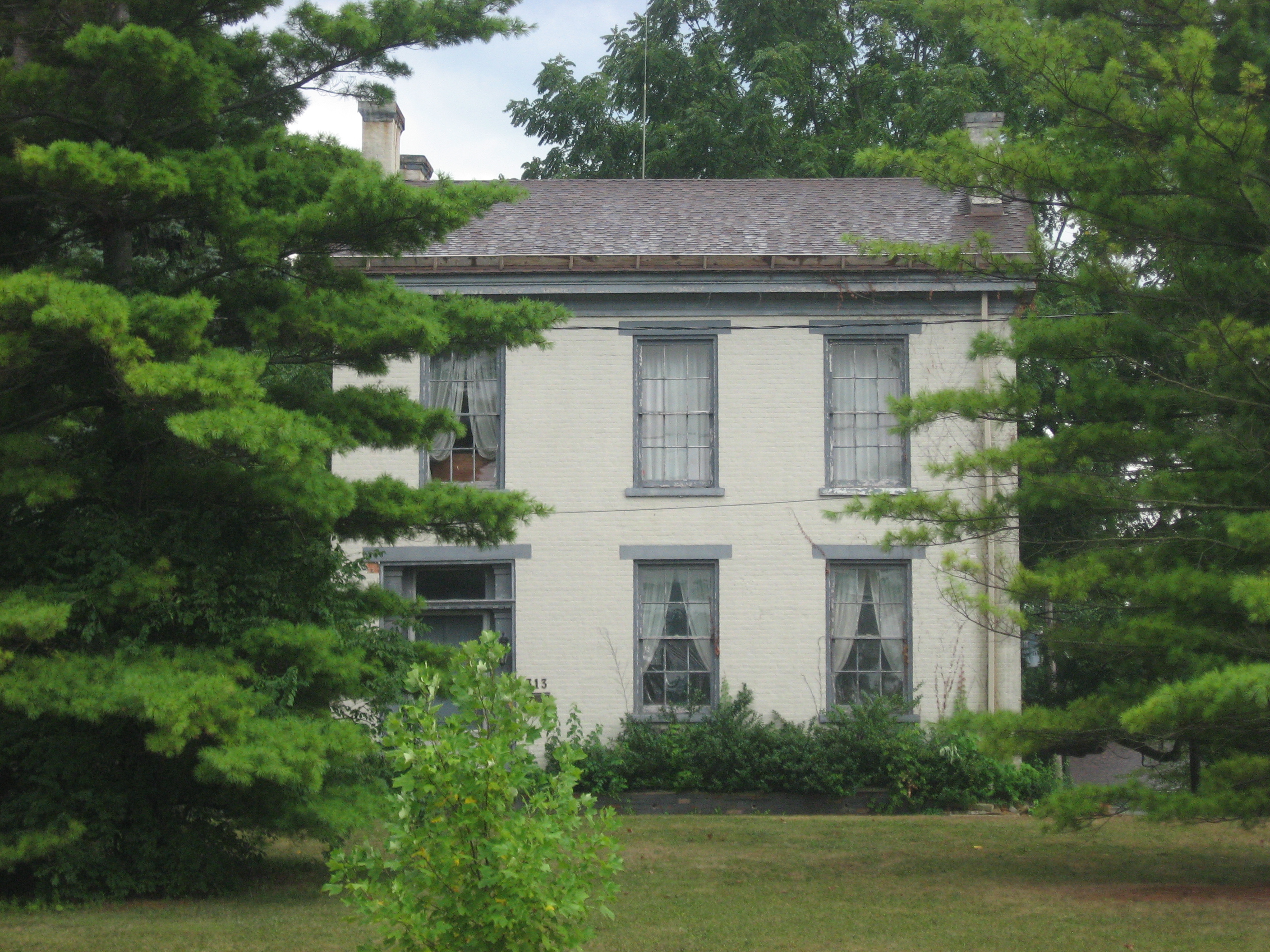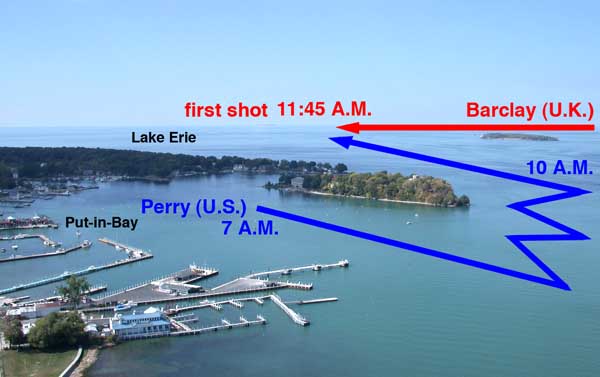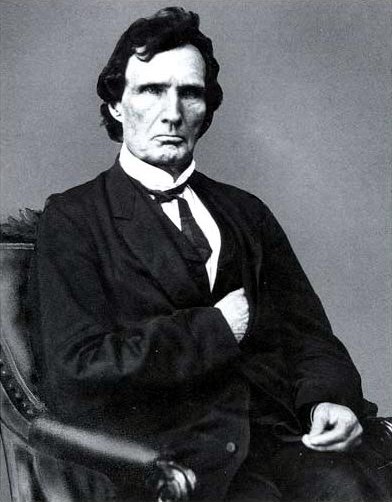|
Oliver Hazard Perry Morton
Oliver Hazard Perry Throck Morton (August 4, 1823 – November 1, 1877), commonly known as Oliver P. Morton, was a U.S. Republican Party politician from Indiana. He served as the 14th governor (the first native-born) of Indiana during the American Civil War, and was a stalwart ally of President Abraham Lincoln. During the war, Morton thwarted and neutralized the Democratic-controlled Indiana General Assembly. He exceeded his constitutional authority by calling out the militia without approval, and during the period of legislative suppression he privately financed the state government through unapproved federal and private loans. He was criticized for arresting and detaining political enemies and suspected southern sympathizers. As one of President Lincoln's "war governors", Morton made significant contributions to the war effort, more than any other man in the state, and earned the lifelong gratitude of former Union soldiers for his support. During his second term as governor, ... [...More Info...] [...Related Items...] OR: [Wikipedia] [Google] [Baidu] |
Wayne County, Indiana
Wayne County is a county located in east central Indiana, United States, on the border with Ohio. As of the 2010 census, the population was 68,917. The county seat is Richmond. Wayne County comprises the Richmond, IN Micropolitan Statistical Area. Richmond hosts Earlham College, a small private liberal arts college. History The first permanent European-American settlers in the area were Quakers from North Carolina. They settled about 1806 near the east fork of the Whitewater River, an area including what is today the city of Richmond. Jeptha Turner, the first white child in the county, was born here in 1806. Wayne County was formed in 1811 from portions of Clark and Dearborn counties. It was named for Gen. "Mad" Anthony Wayne, who was an officer during the Revolutionary War. Wayne is mainly remembered for his service in the 1790s in the Northwest Indian War, which included many actions in Indiana and Ohio. The first county seat was Salisbury, Indiana, a town which no l ... [...More Info...] [...Related Items...] OR: [Wikipedia] [Google] [Baidu] |
American Civil War
The American Civil War (April 12, 1861 – May 26, 1865; also known by other names) was a civil war in the United States. It was fought between the Union ("the North") and the Confederacy ("the South"), the latter formed by states that had seceded. The central cause of the war was the dispute over whether slavery would be permitted to expand into the western territories, leading to more slave states, or be prevented from doing so, which was widely believed would place slavery on a course of ultimate extinction. Decades of political controversy over slavery were brought to a head by the victory in the 1860 U.S. presidential election of Abraham Lincoln, who opposed slavery's expansion into the west. An initial seven southern slave states responded to Lincoln's victory by seceding from the United States and, in 1861, forming the Confederacy. The Confederacy seized U.S. forts and other federal assets within their borders. Led by Confederate President Jefferson Davis, ... [...More Info...] [...Related Items...] OR: [Wikipedia] [Google] [Baidu] |
Ohio
Ohio () is a state in the Midwestern region of the United States. Of the fifty U.S. states, it is the 34th-largest by area, and with a population of nearly 11.8 million, is the seventh-most populous and tenth-most densely populated. The state's capital and largest city is Columbus, with the Columbus metro area, Greater Cincinnati, and Greater Cleveland being the largest metropolitan areas. Ohio is bordered by Lake Erie to the north, Pennsylvania to the east, West Virginia to the southeast, Kentucky to the southwest, Indiana to the west, and Michigan to the northwest. Ohio is historically known as the "Buckeye State" after its Ohio buckeye trees, and Ohioans are also known as "Buckeyes". Its state flag is the only non-rectangular flag of all the U.S. states. Ohio takes its name from the Ohio River, which in turn originated from the Seneca word ''ohiːyo'', meaning "good river", "great river", or "large creek". The state arose from the lands west of the Appalachian Mountai ... [...More Info...] [...Related Items...] OR: [Wikipedia] [Google] [Baidu] |
Battle Of Lake Erie
The Battle of Lake Erie, sometimes called the Battle of Put-in-Bay, was fought on 10 September 1813, on Lake Erie off the shore of Ohio during the War of 1812. Nine vessels of the United States Navy defeated and captured six vessels of the British Royal Navy. This ensured American control of the lake for the rest of the war, which in turn allowed the Americans to recover Detroit and win the Battle of the Thames to break the Indian confederation of Tecumseh. It was one of the biggest naval battles of the War of 1812. Background 1812 When the war broke out, the British immediately seized control of Lake Erie. They already had a small force of warships there: the sloop-of-war and the brig ''General Hunter''. The schooner was under construction and was put into service a few weeks after the outbreak of war. These vessels were controlled by the Provincial Marine, which was a military transport service and not a naval service. Nevertheless, the Americans lacked any counter to the ... [...More Info...] [...Related Items...] OR: [Wikipedia] [Google] [Baidu] |
Commodore (USN)
Commodore was an early title and later a Military rank, rank in the United States Navy, United States Coast Guard and the Confederate States Navy, and also has been a rank in the United States Public Health Service Commissioned Corps and the National Oceanic and Atmospheric Administration Commissioned Officer Corps (NOAA Corps) and its ancestor organizations. For over two centuries, the designation has been given varying levels of authority and formality. Today, it is no longer a specific rank within Active duty, active-duty or Military reserve force, reserve forces or in the Public Health Service Commissioned Corps or NOAA Corps, but it remains in use as an ''honorary title'' within the U.S. Navy and U.S. Coast Guard for those senior Captain (United States O-6), captains (pay grade O-6) in command of operational organizations composed of multiple independent subordinate naval units (e.g., multiple independent ships or aviation squadrons). However, "commodore" is a rank that i ... [...More Info...] [...Related Items...] OR: [Wikipedia] [Google] [Baidu] |
Oliver Hazard Perry
Oliver Hazard Perry (August 23, 1785 – August 23, 1819) was an American naval commander, born in South Kingstown, Rhode Island. The best-known and most prominent member of the Perry family naval dynasty, he was the son of Sarah Wallace Alexander and United States Navy Captain Christopher Raymond Perry, and older brother of Commodore Matthew C. Perry. Perry served in the West Indies during the Quasi War of 1798–1800 against France, in the Mediterranean during the Barbary Wars of 1801–1815, and in the Caribbean fighting piracy and the slave trade, but is most noted for his heroic role in the War of 1812 during the 1813 Battle of Lake Erie. During the war against Britain, Perry supervised the building of a fleet at Erie, Pennsylvania. He earned the title "Hero of Lake Erie" for leading American forces in a decisive naval victory at the Battle of Lake Erie, receiving a Congressional Gold Medal and the Thanks of Congress. Bloom, Page essay His leadership materially aid ... [...More Info...] [...Related Items...] OR: [Wikipedia] [Google] [Baidu] |
Oliver P
Oliver may refer to: Arts, entertainment and literature Books * ''Oliver the Western Engine'', volume 24 in ''The Railway Series'' by Rev. W. Awdry * ''Oliver Twist'', a novel by Charles Dickens Fictional characters * Ariadne Oliver, in the novels of Agatha Christie * Oliver (Disney character) * Oliver Fish, a gay police officer on the American soap opera ''One Life to Live'' * Oliver Hampton, in the American television series ''How to Get Away with Murder'' * Oliver Jones (''The Bold and the Beautiful''), on the American soap opera ''The Bold and the Beautiful'' * Oliver Lightload, in the movie ''Cars'' * Oliver Oken, from ''Hannah Montana'' * Oliver (paladin), a paladin featured in the Matter of France * Oliver Queen, DC Comic book hero also known as the Green Arrow * Oliver (Thomas and Friends character), a locomotive in the Thomas and Friends franchise * Oliver Trask, a controversial minor character from the first season of ''The O.C.'' * Oliver Twist (character ... [...More Info...] [...Related Items...] OR: [Wikipedia] [Google] [Baidu] |
Crown Hill Cemetery
Crown Hill Cemetery is a historic rural cemetery located at 700 West 38th Street in Indianapolis, Marion County, Indiana. The privately owned cemetery was established in 1863 at Strawberry Hill, whose summit was renamed "The Crown", a high point overlooking Indianapolis. It is approximately northwest of the city's center. Crown Hill was dedicated on June 1, 1864, and encompasses , making it the third largest non-governmental cemetery in the United States. Its grounds are based on the landscape designs of Pittsburgh landscape architect and cemetery superintendent John Chislett Sr and Prussian horticulturalist Adolph Strauch. In 1866, the U.S. government authorized a U.S. National Cemetery for Indianapolis. The Crown Hill National Cemetery is located in Sections 9 and 10. Crown Hill contains of paved road, over 150 species of trees and plants, over 225,000 graves, and services roughly 1,500 burials per year. Crown Hill is the final resting place for individuals from all walks ... [...More Info...] [...Related Items...] OR: [Wikipedia] [Google] [Baidu] |
Southern Confederacy
The Confederate States of America (CSA), commonly referred to as the Confederate States or the Confederacy was an unrecognized breakaway republic in the Southern United States that existed from February 8, 1861, to May 9, 1865. The Confederacy comprised U.S. states that declared secession and warred against the United States during the American Civil War: South Carolina, Mississippi, Florida, Alabama, Georgia, Louisiana, Texas, Virginia, Arkansas, Tennessee, and North Carolina. Kentucky and Missouri also declared secession and had full representation in the Confederate Congress, though their territory was largely controlled by Union forces. The Confederacy was formed on February 8, 1861, by seven slave states: South Carolina, Mississippi, Florida, Alabama, Georgia, Louisiana, and Texas. All seven were in the Deep South region of the United States, whose economy was heavily dependent upon agriculture—particularly cotton—and a plantation system that relied upon enslaved ... [...More Info...] [...Related Items...] OR: [Wikipedia] [Google] [Baidu] |
Reconstruction Era Of The United States
The Reconstruction era was a period in History of the United States, American history following the American Civil War (1861–1865) and lasting until approximately the Compromise of 1877. During Reconstruction, attempts were made to rebuild the country after the bloody Civil War, bring the former Confederate States of America, Confederate states back into the United States, and to redress the political, social, and economic legacies of slavery. During the era, United States Congress, Congress Abolitionism in the United States, abolished slavery, ended the remnants of Secession in the United States, Confederate secession in the Southern United States, South, and passed the Thirteenth Amendment to the United States Constitution, 13th, Fourteenth Amendment to the United States Constitution, 14th, and Fifteenth Amendment to the United States Constitution, 15th Amendments to the Constitution (the Reconstruction Amendments) ostensibly guaranteeing the newly freed slaves (Freedma ... [...More Info...] [...Related Items...] OR: [Wikipedia] [Google] [Baidu] |
Radical Republicans
The Radical Republicans (later also known as " Stalwarts") were a faction within the Republican Party, originating from the party's founding in 1854, some 6 years before the Civil War, until the Compromise of 1877, which effectively ended Reconstruction. They called themselves "Radicals" because of their goal of immediate, complete, and permanent eradication of slavery, without compromise. They were opposed during the War by the Moderate Republicans (led by President Abraham Lincoln), and by the pro-slavery and anti-Reconstruction Democratic Party. Radicals led efforts after the war to establish civil rights for former slaves and fully implement em ... [...More Info...] [...Related Items...] OR: [Wikipedia] [Google] [Baidu] |
United States Senate
The United States Senate is the upper chamber of the United States Congress, with the House of Representatives being the lower chamber. Together they compose the national bicameral legislature of the United States. The composition and powers of the Senate are established by Article One of the United States Constitution. The Senate is composed of senators, each of whom represents a single state in its entirety. Each of the 50 states is equally represented by two senators who serve staggered terms of six years, for a total of 100 senators. The vice president of the United States serves as presiding officer and president of the Senate by virtue of that office, despite not being a senator, and has a vote only if the Senate is equally divided. In the vice president's absence, the president pro tempore, who is traditionally the senior member of the party holding a majority of seats, presides over the Senate. As the upper chamber of Congress, the Senate has several powers o ... [...More Info...] [...Related Items...] OR: [Wikipedia] [Google] [Baidu] |







